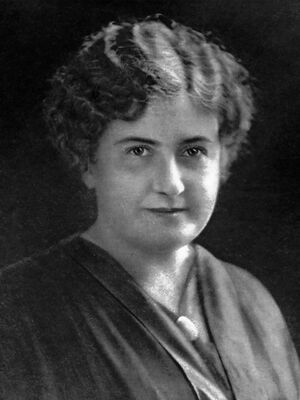Maria Montessori/pt: Difference between revisions
(Created page with "As crianças têm um grande poder de concentração e um amor extraordinário pela ordem, e entre os dois e os sete anos, prezam os rituais. Também têm preferência pela exe...") |
(Created page with "Ela descobriu ainda que as crianças têm um sentido de tato apurado e aprendem com as mãos, mais do que com os olhos. Por isso, criou sistemas aos quais deu o nome de desen...") |
||
| Line 20: | Line 20: | ||
e estudar. | e estudar. | ||
Ela descobriu ainda que as crianças têm um sentido de tato apurado e aprendem com as mãos, mais do que com os olhos. Por isso, criou sistemas aos quais deu o nome de desenvolvimento sensorial. As crianças | |||
também apreciam a liberdade de escolha. As salas de aula Montessori | |||
são idealizadas de forma a permitir que cada criança selecione o grupo | |||
de blocos ou o material de treinamento que usará em um dado momento | |||
– um momento cósmico – quando a alma estiver pronta para se | |||
desenvolver naquele ponto específico. | |||
Children age two and one-half through six are all in one classroom so that the younger children can see the more advanced work of the older children and they can learn from their example. A Montessori teacher’s role is to direct the child toward the exercises. | Children age two and one-half through six are all in one classroom so that the younger children can see the more advanced work of the older children and they can learn from their example. A Montessori teacher’s role is to direct the child toward the exercises. | ||
Revision as of 03:12, 15 May 2020

Maria Montessori é uma chela da Mãe Maria e, ao usar o seu manto, estabeleceu os fundamentos da educação dos mestres ascensos para a era de Aquário. Como mensageira da hierarquia na área da educação, recebia instruções diretamente da Mãe Maria, de Jesus e de Kuthumi.
Maria Montessori nasceu na Itália, em 1870, e foi a primeira médica italiana. Quando trabalhava em Roma, recebeu a incumbência de cuidar das crianças de um jardim de infância, em um bairro pobre da cidade. Ao observar os pequeninos, ela desenvolveu o trabalho que ficou conhecido como Método Montessori.
Maria Montessori percebeu nas crianças qualidades diferentes e específicas, que ninguém percebera antes. E constatou que, em um ambiente apropriado e sob condições adequadas, essas qualidades podem manifestar-se.
Uma das suas primeiras descobertas foi a de que as crianças preferem trabalhar a brincar. São diligentes e, se o trabalho for organizado, podem desenvolver padrões internos que auxiliarão o seu desenvolvimento.
As crianças têm um grande poder de concentração e um amor extraordinário pela ordem, e entre os dois e os sete anos, prezam os rituais. Também têm preferência pela execução de tarefas ordenadas. O objetivo da criança não é terminar a tarefa com rapidez, mas fazê-la sistematicamente. Montessori compreendeu que os padrões de ordem e de lógica desenvolvidos na criança por meio de movimentos físicos, mais tarde reforçarão a sua habilidade para aprender, concentrar-se e estudar.
Ela descobriu ainda que as crianças têm um sentido de tato apurado e aprendem com as mãos, mais do que com os olhos. Por isso, criou sistemas aos quais deu o nome de desenvolvimento sensorial. As crianças também apreciam a liberdade de escolha. As salas de aula Montessori são idealizadas de forma a permitir que cada criança selecione o grupo de blocos ou o material de treinamento que usará em um dado momento – um momento cósmico – quando a alma estiver pronta para se desenvolver naquele ponto específico.
Children age two and one-half through six are all in one classroom so that the younger children can see the more advanced work of the older children and they can learn from their example. A Montessori teacher’s role is to direct the child toward the exercises.
In a Montessori classroom you will find little children at their tables preoccupied for great lengths of time, concentrating on their lessons. They have an amazing power of concentration. They learn mathematics with concrete equipment such as beads or blocks designed to teach the association of numerals and quantity. They learn writing and reading, but they do it according to the pattern of their own unique inner development. Children are not rushed or forced to do something that does not come easily and naturally to them. The teacher’s role is to encourage independent learning as the child listens to his own inner teacher. Maria Montessori discovered that the call of the universal child is, “Help me to do it myself.”
All of these things were revealed to Maria Montessori by the children themselves. She said that all she did was watch the children, and they taught her the method.
The Montessori method is intended to bring out the Christ potential of the child, as the child follows the direction of the inner teacher and selects in the classroom certain equipment and exercises that are appropriate for fulfillment of the inner and spiritual needs of the child and to bring forth the inner attainment. The combined freedom and order in the Montessori classroom is the true Aquarian-age education.
The Montessori method for children was inspired upon Maria Montessori by Mother Mary. Mary explained that this was the method she had devised with Elizabeth for teaching John the Baptist and Jesus when they were children.
Sources
Mark L. Prophet and Elizabeth Clare Prophet, The Masters and Their Retreats, s.v. “Maria Montessori.”
